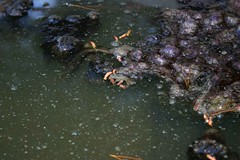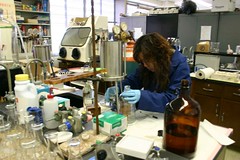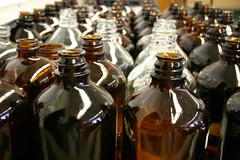Down splashes the water! streaking down the street! swiveling around tires and slipping around oily stains! Leaves collect in pitching masses. Flotillas of cigarette butts gurgle and boil with human spit-um and dog, bird, and unknown animal shit and vomit. Parts of decaying animals lurking in the dark street drains, swallow the incoming waters and mix it all up with the pesticides and herbicides skimmed from silly urban "gardens."
Sunlight kills many of the floating micro-organisms hacked up from diseased lungs and sickly bowels. But enough of the organisms attach to the coffee cups and plastic bags that cram the storm drains that rush to the sea.
This is just a picture of some water in a plastic pot that used to be clear.
It used to be free of horrors.
There used to be mosquito fish (which ate the mosquitoes) and damsel and dragon flies (which ate the fish and mosquito larva and adults).
Then we poured pesticides and other PAHs and plasticizers and mercury and lead and zinc and Tylenol and estrogen and drugs that prevent psychotic episodes in people - all the stuff that run down our streets into the sea and lakes and rivers and streams.
First the fish died. Then the dragon flies died. Then the algae and cyano-bacteria pulled up from the soil which covered floor of the pots. There were greasy globules of oily substances that kept things floating in suspension, There grew a skin of a sort that slowly rotated in the changing temperatures of the day. The water never settled out. Then the fungus grew. Bubbling thick masses of black and pink burped musty puffs of spores. You can smell the fungus for many meters from the pots.
Then one day, floating on the top were many mosquito eggs. The larvae hatched. They wiggled to the surface to sucked in their first gulp of fresh air.
They ate the algae and shed their skins of chitin and toxins.
Then another batch emerged.
The first batch died then the second ate the dead of the first. Little round heads of mosquito larvae bob at the bottom of the pots. With each new batch of mosquito larvae, the water cleared. With each new batch of mosquito larvae, they became more and more tolerant of the pesticides and other toxins that might kill them. Finally, the adults emerge from their pupas, ready to mate ... hauling out their shoulders from the slick surface. Masses of flies dancing in the pools of dwindling sunlight. ... and then the females, ready to take their first blood meal so they can lay the next generation of mosquito - able to tolerate the insecticides that killed its predecessors....
Tuesday, April 25, 2006
Friday, April 14, 2006
early-morning-moon
Early in the morning, when only the mocking bird sings, is an odd time. In winter, crickets don't sing. It is too cold. I find this time unpleasant because it is so alone.... Just the mocking bird and I. One can ponder ephemeral life .... my own and others. How silly it is to think we live forever. How frightening to think that we could be stuck in a 'heaven' of our own design.... strumming a harp or using up virgins.... floating toward some light... both of which sound like hell ... long sleep isn't so bad.
Wednesday, April 05, 2006
Playa Vista
So, while I was taking the photos of these panoramas of Ballona wetlands - in the man-made freshwater section (they use sprinklers to water the 'natural' wetland areas) - I was thinking of Global Warming.... I can almost see people purposefully crushing the life of the entire planet .... every time I watch a television show or listen to a radio program they are selling car after car after car .... I can watch images of melting mountains of ice at poles with each new line of vehicle ... the deep ocean currents changing directions as the trucks roll by tearing out trees and planting lawns ...
bluffs at Ballona
The cold water sinks, and salt water is heavier and has a lower freezing point. Deep ocean water, is at or below freezing but is liquid from the its salinity and great pressure. The ocean waters are never still, they move and change latitudes and longitudes and pour around the contours of the sea floor and continental shelves. The surface temperatures are warmed at the equator. The winds and the currents pump the air and water like a heart from the pull of the moon, the temperature changes of the seasons, and by the changes of night and day. The deep earth vents, and the cold, melted freshwater from land further churn the oceans. Our over use of fossil fuels, the burning and destruction of forests, mountains of trash and manure, loss of green forested land for cement are all contributing to the change of CO2/N over O2....
There were a few other times when our planet went through such changes in a short period of time. The first great death happened when the first organisms to photosynthesize created so much oxygen it killed the methane breathers... Then there was another great death when atmospheric oxygen plummeted from 21% to less then 12 % in only 20 million years. Land vertebrates at sea level had the same amount of oxygen as if they were at present day 9,200 foot mountain ... The Late Permian Early Triassic saw 90 % of the ocean organisms die and 75 % of the land plants and animals die. What a horrible death it must have been for not only did the oxygen vanish, but CO2 increased and with it temperatures. The earth became a steamy hot box with not much to breath...
http://www.uwnews.org/article.asp?articleID=9592
There were a few other times when our planet went through such changes in a short period of time. The first great death happened when the first organisms to photosynthesize created so much oxygen it killed the methane breathers... Then there was another great death when atmospheric oxygen plummeted from 21% to less then 12 % in only 20 million years. Land vertebrates at sea level had the same amount of oxygen as if they were at present day 9,200 foot mountain ... The Late Permian Early Triassic saw 90 % of the ocean organisms die and 75 % of the land plants and animals die. What a horrible death it must have been for not only did the oxygen vanish, but CO2 increased and with it temperatures. The earth became a steamy hot box with not much to breath...
http://www.uwnews.org/article.asp?articleID=9592
Ying
In the end, after hours. days, years of work, you must publish. Then after that, you hope that what you have done will be of use to those who come after you to do similar or related work. The tedium of much of the everyday stuff is like any other job, but perhaps more like the tedium of art.
The initial idea of a painting is exciting. Then the sketches begin. So many of the sketches that you produce are not up to the ideas that you think you have done in the past... doubts creep in... but that is all part of the fight. With a blank canvas, hope is renewed but then so are the new worries. For most of the painting, you hate it. Love returns only near the end where you just can't get enough of the brush strokes, the colors, the shapes. Damn!
The initial idea of a painting is exciting. Then the sketches begin. So many of the sketches that you produce are not up to the ideas that you think you have done in the past... doubts creep in... but that is all part of the fight. With a blank canvas, hope is renewed but then so are the new worries. For most of the painting, you hate it. Love returns only near the end where you just can't get enough of the brush strokes, the colors, the shapes. Damn!
Bottles
I have been submerged in two very engrossing projects ... one that is testing the efficiency of wetlands in taking up pollutants (pesticides, PAHs, metals, drugs) by isolating the two major wetland plants and the soils from a source in the man made wetlands of Sweetwater Reservoir... and the other is sampling the runoff water from the parts of the Los Angeles Basin which feeds the Ballona Wetlands. Both studies can finish with many useful concepts and discoveries. They are both very labor intensive, and even with the simplest tools for collection, filtration, oxygen, sampling, and other thoughtful considerations of protecting and stabilizing pollution constituents after capture, there is just not enough people, time or money.
Liters and liters of water must be collected in hopes to capture the tiniest amount of some chemicals. The water must be prepared for storage, and then carefully kept from light. Many times the tiniest amounts, perhaps in parts per million (even trillion), can have dire effects on those (people and other animals) who drink or swim in the water. Then to isolate and find those compounds which have been shown to produce adverse affects, the equipment for finding them must be calibrated (and sensitive) to those amounts. Then the number of times the water must be collected (or for any other scientific study... the number samples ) must be high enough to demonstrate a trend - in other words - to have significance.
Liters and liters of water must be collected in hopes to capture the tiniest amount of some chemicals. The water must be prepared for storage, and then carefully kept from light. Many times the tiniest amounts, perhaps in parts per million (even trillion), can have dire effects on those (people and other animals) who drink or swim in the water. Then to isolate and find those compounds which have been shown to produce adverse affects, the equipment for finding them must be calibrated (and sensitive) to those amounts. Then the number of times the water must be collected (or for any other scientific study... the number samples ) must be high enough to demonstrate a trend - in other words - to have significance.
Subscribe to:
Comments (Atom)





